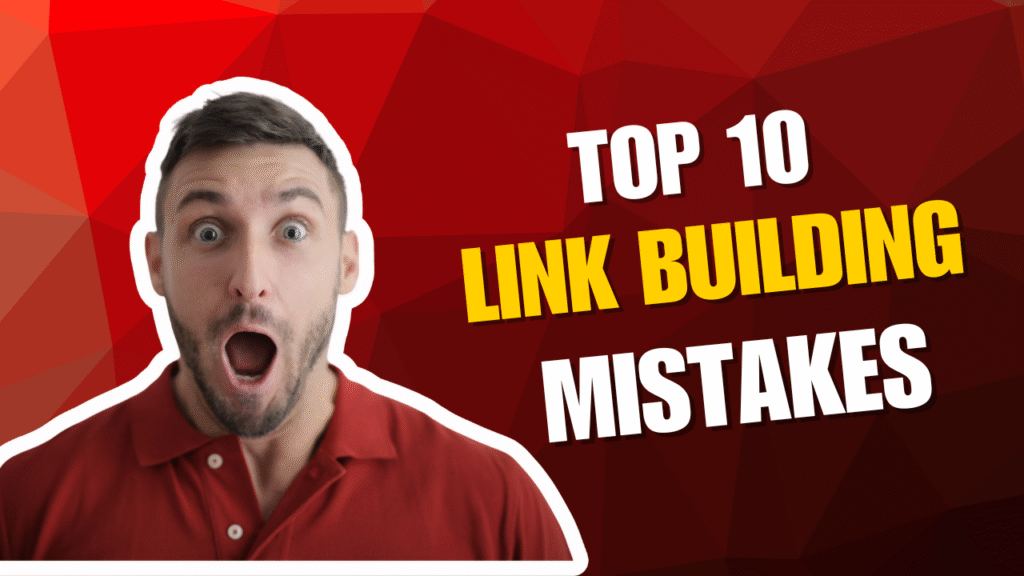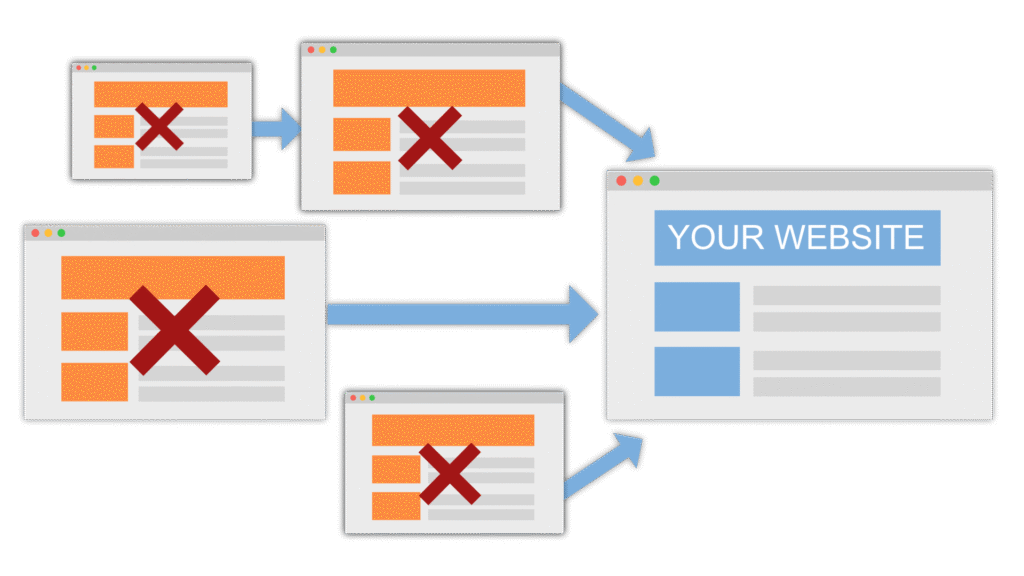Link Building Mistakes That Are Killing Your Rankings in 2025 (Fix It Now)

Link building is still one of the most powerful ranking factors in SEO, even in 2025. But here’s the problem: while it’s essential for building authority and trust in Google’s eyes, it’s also incredibly easy to get wrong.
The SEO landscape has changed dramatically in recent years with Google’s updates like SpamBrain and the Helpful Content Update becoming more sophisticated at detecting unnatural link patterns. That means strategies that worked five years ago might now trigger penalties or cause ranking drops.
If you’ve been relying on the same link building tactics since 2018 chances are they’re either outdated, risky, or flat-out harmful today. The challenge for business owners, marketers, and SEO specialists is knowing which practices are still effective and which are silently sabotaging rankings.
In this article, we’ll uncover the most common link building mistakes in 2025 explain why they’re dangerous, and give you actionable tips to fix them so your link profile can actually help your site grow, not sink.
Table of Contents
Common Link Building Mistakes That Are Killing Your Rankings in 2025
Mistake #1: Relying on Low-Quality Guest Posts
Guest posting still works in 2025, but not in the way many people think. Too many marketers treat it like a numbers game, pumping out dozens of thin, low-quality posts on irrelevant blogs just to score a backlink.
The problem is that Google is now extremely good at spotting guest post farms websites that exist only to sell guest post space and publish anything for a price. Links from these sites have little to no value and, in some cases, can actively harm your rankings.
- Example: if your fintech startups writes a guest post for a low-authority pet grooming blog, that link screams manipulation to search engines. It’s completely irrelevant and adds no contextual value.
- How To Fix: Focus on quality over quantity. Target niche-relevant sites with genuine audiences, build relationships with editors and craft content that actually helps readers. One guest post on an authority site in your niche is worth more than 20 irrelevant ones on spammy blogs.
Mistake #2: Ignoring Link Relevance
Not all backlinks are created equal. In 2025 link relevance plays a bigger role than ever. Google doesn’t just look at the authority of a linking site it evaluates whether that site is topically related to yours A backlink from a high-DA website in a completely unrelated industry can be seen as manipulative.
- Example: if you run a health and fitness blog but get most of your backlinks from car review websites, there’s a clear disconnect. Those links might still pass some authority, but they won’t help much with rankings and could be flagged as spam signals if the pattern continues.
- How To Fix: Only pursue backlinks from sites that align with your niche. If your content is about finance, aim for backlinks from finance, business, and investment-related sites. This not only boosts your SEO but also drives qualified referral traffic that’s more likely to convert.
Mistake #3: Overusing Exact Match Anchor Text
Anchor text the clickable words in a hyperlink still matters for SEO but overusing exact match keywords is one of the fastest ways to trigger a penalty. Back in the early 2010s, exact match anchors were a cheat code for ranking fast. But after the Penguin update and years of refinements Google now sees over-optimized anchor text profiles as a red flag.
- For example: if your site is targeting “best running shoes” and 80% of your backlinks use that exact phrase it looks unnatural. Real websites attract a mix of branded anchors, generic anchors, and partial match anchors.
- Fix: Keep your anchor text profile varied. Use branded terms, URL anchors, and natural phrases alongside partial and exact matches. A healthy profile is diverse and mirrors the way people naturally link online.
Mistake #4: Buying Links from Shady Sources
Link buying has always been against Google’s guidelines but in 2025 it’s riskier than ever. Many shady vendors promise “100 DA90+ backlinks for $50,” which sounds like a dream but usually delivers spammy, irrelevant links from private blog networks (PBNs) or hacked sites.
With the rise of SpamBrain Google can detect link-selling footprints at scale. If your site is caught buying links from obvious networks, you risk deindexation or a massive ranking drop. Worse, once your domain is flagged recovery can be long and expensive.
- Fix: Stick to white-hat link building methods Outreach, content marketing, digital PR, and relationship building are slower, but they produce links that last and won’t get you penalized.
Mistake #5: Neglecting Internal Linking
While everyone talks about backlinks from other sites internal links are often overlooked yet they’re crucial for SEO. Internal linking helps distribute authority across your site, makes it easier for Google to crawl pages, and improves user navigation.
If you’re publishing new content but never linking it to existing articles you’re missing out on a huge opportunity. Orphan pages (pages with no internal links) often fail to rank, no matter how good the content is.
- Fix: Create topic clusters where each piece of content links to related pages. Use descriptive, keyword-rich anchors to guide both users and search engines. An optimized internal linking strategy can boost rankings for multiple pages at once.
Mistake #6: Not Monitoring Toxic Backlinks
Toxic backlinks are like termites in your SEO foundation you may not notice the damage until it’s too late. These links often come from spammy, irrelevant, or malicious websites. They can be the result of negative SEO attacks, automated link-building tools, or past mistakes.
If toxic links pile up Google may associate your site with low-quality content, leading to ranking drops. Even if you didn’t create these links yourself you are still responsible for cleaning them up.
- Fix: Run backlink audits monthly using tools like Ahrefs, SEMrush, or Google Search Console. If you find harmful links, use the disavow tool to tell Google not to count them against you.

Mistake #7: Building Links Too Fast (Unnatural Link Velocity)
Link velocity refers to how quickly you acquire backlinks While gaining links is good but gaining too many too fast especially for a new site can raise suspicion.
if a brand-new blog gets 500 backlinks in a single week from unrelated domains it’s almost certainly unnatural Google expects link growth to be steady and proportional to your site age, authority, and content output.
- Fix: Focus on gradual, consistent growth. Combine link building with ongoing content marketing so new backlinks come in naturally over time.
Mistake #8: Ignoring NoFollow and UGC Attributes
Not every link is meant to pass SEO value. In some cases, links should be tagged with rel=”nofollow” or rel=”ugc” (user-generated content) to signal their nature. Failing to use these attributes can make your link profile look suspicious.
For example: if you allow followed links in blog comments, you could unintentionally give link juice to spammy sites. This not only wastes your site’s authority but could result in penalties.
- Fix: Review your outbound links regularly Use nofollow tags for sponsored content and UGC tags for comments or forum posts.
Mistake #9: Relying Solely on One Link Source
A healthy backlink profile is diverse If all your links come from one source say guest posts you’re vulnerable to algorithm changes or policy shifts that devalue that tactic.
if guest posting becomes less effective due to stricter Google guidelines a site relying on it exclusively will see a sharp ranking drop.
- Fix: Use a mix of strategies guest posting, HARO, digital PR, niche edits, and resource page outreach. This ensures your link profile remains strong, even if one source loses value.
Mistake #10: Not Updating Old Backlinks
Even great backlinks can lose power over time if the page they’re on gets outdated or deleted. Broken backlinks waste link equity and can lead to lost rankings.
if you got a backlink in 2020 from a high-authority blog post that has since been removed, you’ve lost that SEO boost.
- Fix: Monitor your backlink profile for lost or broken links reach out to site owners to restore or update them. If a page is outdated, offer updated content in exchange for keeping the link active.
What Works in Link Building in 2025
Link building in 2025 is less about chasing any link you can get and more about earning relevant, high-authority links that make sense for your niche. With Google AI-driven updates like SpamBrain actively filtering spammy patterns, the safest and most effective strategies are ones that focus on quality, trust, and topical relevance.
Here are the methods that work best right now:
- Digital PR Campaigns: Create newsworthy stories, industry reports, or original research that journalists and bloggers want to reference.
- HARO (Help a Reporter Out) Outreach: By responding to journalist queries with valuable insights, you can get your brand mentioned (with a backlink) in high-authority publications.
- Resource Page Outreach: Find Best of or Recommended Resources pages in your niche and pitch your content or product as a valuable addition.
- Niche Edits: Instead of writing new guest posts, offer to update relevant older blog posts with your fresh insights and earn a contextual backlink in the process.
- Partnership & Collaboration Links: Partner with non-competing businesses for co-branded content, webinars, or studies that naturally generate backlinks.
- Link-Worthy Assets: Publish high-value assets like industry stats, infographics, or free tools that others want to cite.
- Local Link Building: For local businesses, sponsor events, collaborate with local organizations, or get featured in community news sites to build geo-relevant backlinks.
- Podcast Guesting: Appear as a guest on niche podcasts most will include a backlink to your site in the show notes.
- Broken Link Building: Find broken outbound links on authority sites in your niche, create relevant replacement content, and reach out to have your link added.
These strategies are low-risk, high-reward, and when combined, they create a diverse, natural link profile that Google loves.
Link Building Pro Tips & Industry Insights 2025
To really master link building in 2025, you need to think like both a marketer and a search engine. Here what industry experts and data-driven analysis reveal about succeeding in today’s SEO environment:
- Link Velocity Management – Don’t aim for 100 links in a week. Instead, match your growth rate to your content publishing frequency and brand visibility. A slow, steady drip of high-quality links looks more natural than a sudden spike.
- Relevance Over Raw DA – A DA 40 link from a highly relevant site will often outperform a DA 90 link from an unrelated niche. Google is valuing context far more than sheer authority.
- Topical Authority Clusters – Build multiple links within your niche’s subtopics to establish yourself as an authority on that subject.
- Diversify Link Types – Include guest posts, mentions, citations, podcasts, and resource listings. A diverse link profile is harder for algorithms to flag as manipulative.
- Avoid Over-Optimization – Keep exact match anchors to 10–15% of your total backlink profile to stay safe from over-optimization penalties.
- Leverage Internal Links – While external backlinks are key, don’t neglect internal linking to pass authority to important pages.
- Quality Beats Quantity – In every Google core update, sites with fewer but better links outperform those with thousands of low-value ones.
- Monitor Competitors – Track your competitors new backlinks using tools like Ahrefs or Semrush. Often you can target the same opportunities.
- Content Freshness Matters – Update link-worthy content annually to keep attracting backlinks and avoid losing link equity.
- Use AI for Prospecting, Not Spamming – AI tools can help you find potential link partners faster, but the outreach should still be personalized and human.
When you combine these tips with the “What Works” strategies above, you create a link building system that not only boosts rankings but also strengthens your brand’s credibility across the web.
Conclusion
Link building in 2025 is all about relevance, quality, and trust. Outdated tactics like spammy guest posts, shady paid links, and anchor text stuffing no longer work and can destroy your rankings. Audit your backlink profile regularly diversify your link sources and focus on building genuine relationships in your niche.
Is buying backlinks still a bad idea in 2025?
Yes. While some agencies sell “safe” links Google’s spam detection and AI-powered link evaluation in 2025 is much more advanced. If links come from irrelevant, low-quality, or obvious paid placements, they can trigger penalties. The safer route is earning links through PR campaigns, high-value content, and real outreach.
Can using AI-generated content for link building cause issues?
Yes, if done incorrectly. Google doesn’t penalize AI content by default, but if the AI-written article is thin, repetitive, or off-topic it risks deindexation. In 2025 human-edited AI content with unique insights is the safest choice for outreach.
Why is anchor text optimization still causing penalties?
Over-optimized anchors (like using your target keyword in 80% of backlinks) look unnatural to Google’s algorithms. In 2025, a healthy anchor profile mixes branded anchors, naked URLs, generic terms (“click here”), and partial matches.
Is it still okay to get links from guest posts
Yes, but only if:
The site is topically relevant.
The content is original and valuable.
Links are contextually placed, not stuffed
Guest post farms or sites that sell mass placements can harm rankings
How important is link diversity in 2025?
Extremely important. Relying on a single type of link (only guest posts, only directories, etc.) is risky. A healthy backlink profile includes editorial mentions, HARO/PR links, niche directories, resource pages, podcasts, and brand mentions.
Should I remove old backlinks that look spammy?
Yes. Toxic links can still hold you back In 2025 Google ignores some low-quality links, but if there’s a manual action or ranking drop, audit your backlinks quarterly and use the disavow tool when needed.
How can irrelevant links hurt my site in 2025?
If you run a fitness blog but most backlinks come from crypto or gambling sites, Google’s topical relevance algorithm may devalue those links, reducing your authority in your niche.
Is link velocity (speed of link acquisition) still a ranking factor?
Yes, indirectly. A sudden spike of low-quality links can look manipulative, triggering Google’s spam filters. Natural growth patterns faster during product launches or PR campaigns, slower otherwise are safest.
What’s the #1 link building mistake to avoid in 2025
Treating link building as a standalone SEO activity instead of integrating it with content marketing, branding, and PR. In 2025, the most valuable links come from real relationships, authority-building content, and multi-channel promotion.
